What’s the worst a part of having tight hips? Is it strolling just like the Tin Man? The nighttime achiness? The additional effort required to completely transition from a seated to a standing place?
As dangerous as all of that’s, we’d enterprise to say that it is the persistence of tight hips that makes them notably insupportable. You could possibly quickly loosen their demise grip in your pelvis with stretching, mobility, and therapeutic massage, however retaining tight hips free appears like a idiot’s errand. One exercise or day-long stint on the pc, and also you’re proper again to (a really inflexible) sq. one.
If this sounds all too acquainted, relaxation assured: You don’t need to stay with chronically tight hips. Chances are high, you simply have to swap your go-to hip stretches for simpler ones. Or, you might want to enhance your approach. So, when you’re nonetheless doing the identical warmup you realized out of your J.V. monitor coach, hold studying.
To higher perceive what causes tight hips and get them shifting extra freely with the very best stretches for tight hips, we spoke with bodily therapists Grayson Wickham, PT, DPT, founding father of Motion Vault, and Hilary Granat, PT, DPT, proprietor of C.O.R.E. Bodily Remedy. Right here’s what you might want to know.
What causes tight hips within the first place?
Tight hips can manifest in just a few other ways, Granat says. “It may be restricted vary of movement within the hips, ache within the hip space, and it will probably even result in again ache, or vice versa,” that means decrease again points can set off hip tightness, she says. Chances are you’ll really feel discomfort or ache throughout exercise, however tight hips might also trouble you while you’re standing, sitting, or at relaxation.
Wickham explains that tightness in any muscle is often bodily, neurological, or a mixture of each. “Over time, the physique adapts to the positions and postures you spend probably the most time in,” he says. Sadly, most of us sit in chairs all day, which places our hip flexors and hamstrings in a shortened place, typically rendering them tight and weak.
From a neurological perspective, tight hips could also be brought on by low-level muscle contractions your mind is sending to “defend” you. Your nervous system remembers previous accidents, Wickham says, and can use tightness to maintain the physique from shifting in ways in which really feel threatening. It is going to additionally guard you towards your individual weak point and instability.
So, when you sit lots and persist with the identical motion patterns (most individuals stay within the sagittal, or ahead/backward, airplane and infrequently transfer in a side-to-side or rotational sample), your nervous system will do its greatest to restrict your vary of movement to what it is aware of you are able to do. In different phrases, tight hips are your physique’s means of pumping the brakes at any time when potential hazard lies forward.
The advantages of stretching for tight hips
Stretching your hips—which embody your hip flexors, glutes, quadriceps, adductors, and hamstrings—might help enhance hip mobility and alleviate ache and emotions of tightness—however provided that you do it appropriately.
Wickham strongly recommends lively stretching over passive stretching. In a passive stretch, you collapse right into a place and permit gravity and the load of your physique to do the work. Energetic stretching is totally different in that it requires you to contract the goal muscle when you’ve maximally stretched it.
“You’re proving to your nervous system that you simply’re really fairly steady in that place and possibly you actually don’t have to have all these brakes on,” Wickham says.
Self-myofascial launch (aka foam rolling) works equally. Set off factors, that are painful nodules or “knots” that type in muscle tissue and fascia, are areas the place elevated muscle tone is concentrated. Making use of strain to those areas sends suggestions to the nervous system, inflicting it to lower muscle tone.
Whereas lively stretching and self-myofascial launch may be helpful to individuals with tight hips, it’s typically not sufficient to handle the underlying points.
“In case your hips are all the time feeling tight and stretching them hasn’t labored, it might be that they must be strengthened. Numerous the time, we are inclined to put an excessive amount of emphasis on stretching tight muscular tissues as a substitute of strengthening, particularly the hip flexors,” Granat says. “A muscle that’s weak can really feel tight when there’s a lack of motor management and power.”
The most effective stretches for tight hips
The next workouts, demonstrated by Wickham, use self-myofascial launch and lively stretching. You may want an train mat, foam curler, and mobility ball (a tennis or lacrosse ball can even work).
1. Quad muscle and fascia launch
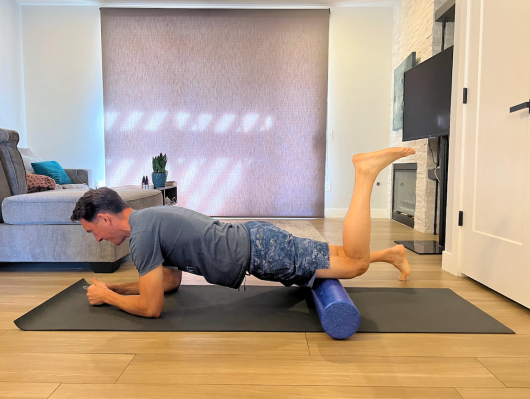
- Begin facedown in your forearms with a foam curler positioned beneath the entrance of your proper thigh. (Extra particularly, apply strain to the rectus femoris, the big muscle positioned within the heart of the quadriceps.) Permit your left leg to relaxation on the ground beside the froth curler.
- Roll and rock your quad over the froth curler till you land on a delicate spot.
- Then, use your physique weight to use strain. “The froth curler needs to be gentle to reasonably uncomfortable. You shouldn’t be tense or wincing in ache,” Wickham says.
- As you preserve strain, maximally bend and straighten your proper knee 3 to 4 instances.
- Modify the positioning of the curler by a millimeter or so to discover a new tender spot. Once more, bend and straighten your knee 3 to 4 instances.
- Repeat for about 2 minutes, then swap legs.
2. Glute muscle and fascia launch
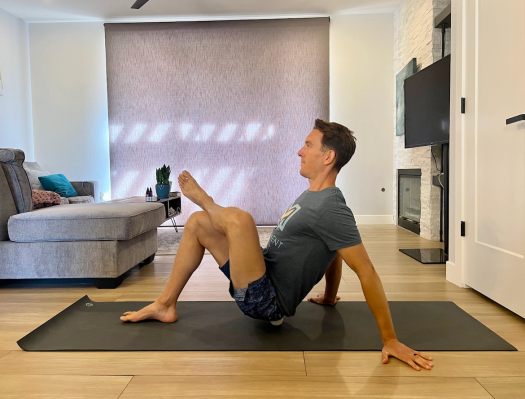
- Sit on the ground together with your left ankle resting in your proper knee. Place a mobility ball beneath your left glute.
- Utilizing your palms and proper leg to keep up steadiness and help your weight, roll your glute over the ball till you land on a delicate spot.
- Pause, permitting the ball to sink into your muscle tissue and fascia. If it feels simpler, you may as well gently rock backwards and forwards over the tender space.
- Shift your place by a millimeter or so and cease while you hit one other tight space. Once more, pause and use your physique weight to use strain to the delicate spot.
- Repeat for about 2 minutes, then swap sides.
3. Energetic 90-90 stretch
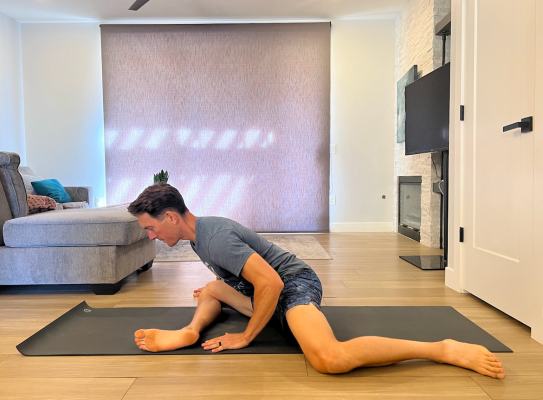
- Sit on the ground together with your legs prolonged in entrance of you.
- Bend your proper knee 90 levels, externally rotate your hip, and relaxation your leg on the bottom in entrance of you.
- Draw your left leg to the aspect and behind you, bending your knee 90 levels in order that the insides of your left thigh and calf are resting on the bottom. Your proper shin needs to be parallel to your left thigh.
- Lean ahead till you’re feeling a deep stretch in your proper glutes and hip.
- Subsequent, drive your proper leg into the bottom in order that the appropriate gluteal muscular tissues contract. Maintain for 10 seconds, then launch the contraction.
- Holding the stretch, attempt to raise your left leg off the bottom. (Even when it doesn’t transfer, hold attempting to raise your leg in order that the left gluteal muscular tissues contract.) Maintain for 10 seconds, then launch the contraction.
- Repeat the sequence 2 instances, then swap legs.
4. Energetic hamstring stretch
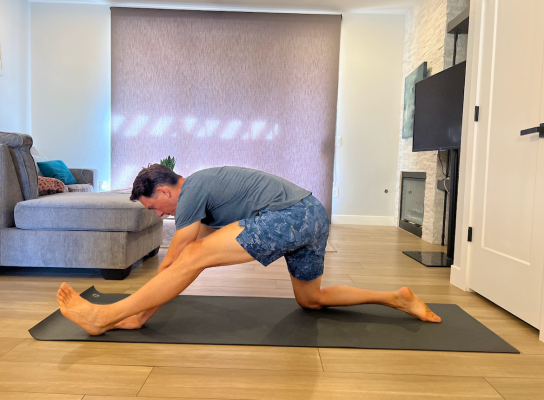
- Begin in a low lunge place together with your left leg in entrance, knee bent 90 levels, and your proper leg prolonged behind you, knee on the bottom.
- Lean ahead and place each palms on the bottom inside your left foot.
- Prolong your left leg and push your hips again till you’re feeling a deep stretch in your left hamstring.
- Holding the stretch, contract your left hamstring by digging your left heel into the bottom.
- Preserve the contraction for 20 seconds, then relaxation for 20 to 30 seconds.
- Repeat the 20-second contraction 2 extra instances, then swap legs.
5. Energetic adductor stretch
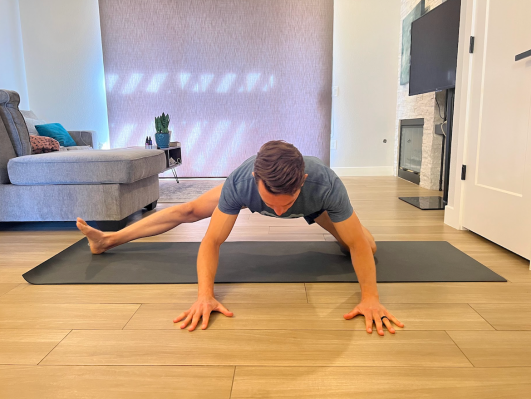
- Begin on all fours together with your knees wider than your hips.
- Prolong your proper leg out the the aspect and flex your foot in order that your heel is on the bottom and your toes are pointing up. Push your hips again till you’re feeling a deep stretch in your interior proper thigh.
- Drive your proper heel into the bottom. “This may trigger your interior thigh adductor muscular tissues to contract whereas they’re maximally stretched out,” Wickham says.
- Maintain the contraction for 20 seconds, then relaxation for 20 to 30 seconds.
- Repeat the 20-second contraction 2 extra instances, then swap legs.
6. Energetic hip flexor stretch
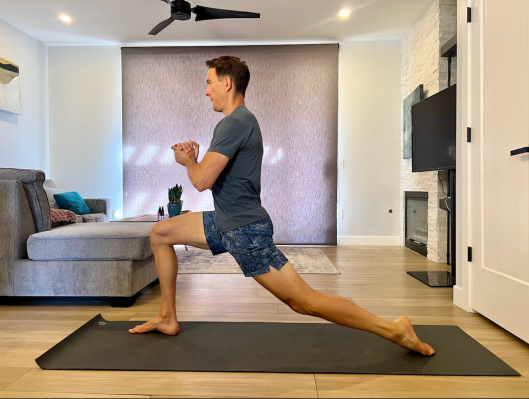
- Begin in a low lunge place together with your proper leg in entrance, knee bent 90 levels, and your left leg prolonged behind you, knee and high of the foot on the bottom.
- Lean ahead barely (you need to really feel a stretch in your left quadriceps and hip flexors) and raise your left knee off the bottom.
- Contract your left quadriceps as exhausting as doable by straightening your leg and driving the highest of the foot into the ground.
- Maintain the contraction for 10 seconds, then relaxation for 20 to 30 seconds.
- Carry out 6 10-second contractions, then swap legs.
Learn how to forestall tight hips as soon as and for all
A daily mobility and lively stretching observe might help hold you limber and forestall your hips from tightening up. Wickham recommends that everybody spend a minimum of 10 minutes on lively stretching thrice per week. These periods ought to embrace each main muscle group, together with your hips.
“It’s lots to get in with inside 10 minutes,” Wickham says. So, individuals with tight hips could wish to tack on a pair extra hip-focused stretch periods throughout which they spend all 10 minutes on the hips, glutes, hamstrings, and quads.
However needless to say 10 minutes received’t undo the whole lot else you’re doing (or not doing) the opposite 23 hours and 50 minutes of the day.
“Keep lively and keep away from extended static positions,” Granat advises. “Take breaks from sitting and preserve good posture to keep away from putting extreme pressure on the hips.”
And whether or not you’re sitting, standing, or shifting, add selection.
“Swap up your postures as a lot as you possibly can all through the day,” Wickham says. “In case you’re sitting in a chair, range the place of your legs. Cross one leg, cross the opposite leg, have each legs out,” he says. And if most of your exercises have you ever shifting ahead (suppose operating, strolling, and biking), think about including in some backward, side-to-side, and rotational actions.
FAQ
1. How lengthy does it take to stretch tight hips?
As famous above, Wickham recommends spending a minimum of 10 minutes on full-body stretching (together with the hips) thrice per week. When you have particularly tight hips, add further time to that baseline so you possibly can concentrate on the hips.
2. Can strolling launch tight hips?
Sure, however strolling alone isn’t sufficient, Granat says. “I all the time say, ‘Movement is lotion.’ Strolling might help by selling blood movement, bettering joint mobility, and fascinating the encompassing muscular tissues,” she says. “Nevertheless, it is vital to enrich strolling with particular hip-strengthening and stretching workouts.”








